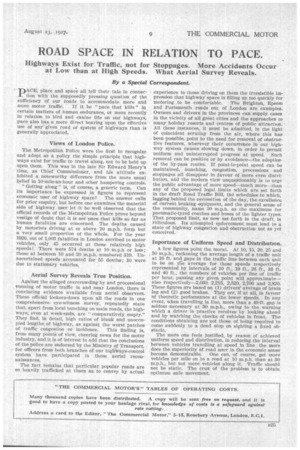ROAD SPACE IN RELATION TO PACE.
Page 43

If you've noticed an error in this article please click here to report it so we can fix it.
Highways Exist for Traffic, not for Stoppages. More Accidents Occur at Low than at High Speeds. What Aerial Survey Reveals.
pDACE, place and space all tell their tale in eonnec-1tion with the supposedly pressing question of the sufficiency of our roads to accommodate more and
more motor traffic. If it be "pace that kills" in certain matters of human endurance, or more recently in relation to bird and canine life on our highways, pace also has a more direct bearing upon the effective use of any given road or system of highways than is generally appreciated.
Views of London Police.
The Metropolitan Police were the first to recognize and adopt as a policy the simple principle that highways exist for traffic to travel along, not to be held up upon them. This was in the late Sir Edward Henry's time, as Chief Commissioner, and his attitude exhibited a noteworthy difference from the more usual belief in 10-mile-an-hour and other hampering controls.
"Getting along" is, of course, a generic term. Can its importance be expressed in figures to represent economic user of highway space? The answer calls for prior enquiry, but before one examines the material side of highway user let it be well observed that the official records of the Methopolitan Police prove beyond vestige of doubt that it is not pace that kills so far as human fatalities are concerned. The deaths caused by motorists driving at or above 20 m.p.h. form but a very small proportion of the whole. For the year 1926, out of 1,003 fatalities in London ascribed to motor vehicles, only 45 occurred at those relatively high speeds! There were 574 deaths at 10 m.p.h or less; those at between 10 and 20 m.p.h. numbered 319. Tinascertained speeds accounted for 55 deaths; 10 were due to stationary vehicles.
Aerial Survey Reveals True Position.
Against the alleged overcrowding by and processional running of motor traffic in and near London, there is convincing evidence available from aerial observers. These official lookers-down upon all the roads in one comprehensive eye-witness survey, repeatedly state that, apart from local bunching on main roads, the highways, even at week-ends, are "comparatively, empty." They find, in detail, high ratios of blank and unoccupied lengths of highway, as against the worst patches of traffic congestion or incidence. This finding is, from many points of view, cheering news for the motor industry, and it is of interest to add that the conclusions of the police are endorsed by the Ministry of Transport, for officers from both branches of our highways-control system have participated in these aerial reconnaissances.
The fact remains that particular popular roads are so heavily trafficked at times as to convey by actual experience to those driving on them the irresistible impression that highway space is filling up too quickly for motoring to be comfortable. The Brighton, Epsom and Portsmouth roads out of London are examples. Owners and drivers in the provinces can supply cases in the vicinity of all great cities and the approaches to many holiday resorts and centres of public attraction. All these instances, it must be admitted, in the light of coincident scrutiny from the air, where this has been possible, point to the need for removal of obstructive features, wherever their occurrence in our highway system causes slowing down, in order to permit uniform and uninterrupted progress at speed. Such removal can be positive or by avoidance—the adoption of the by-pass routes. If point-to-point speed can be maintained, .bunching, congestion, processions and stoppages all disappear in favour of more even distribution, and the modern view unquestionably is to urge the public advantage of more speed—mach more—than any of the proposed legal limits which are set forth in the draft Road Traffic Bill, thd schedules to which, lagging behind the necessities of the day, the excellence of current braking equipment, and the general sense of the community, name 20 m.p.h. as the maximum for pneumatic-tyred coaches and buses of the lighter types. That proposed limit, as now set forth in the draft, is ridiculous. Its attempted enforcement must lead to a state of highway congestion and obstruction not as yet conceived.
Inportance of Uniform Speed and Distribution.
A few figures point the moral. At 10, 15, 20, 25 and 30 m.p.h., reckoning the average length of a traffic unit at 16 ft. and gaps in the traffic line between each unit to be on the average for those speeds respectively represented by intervals of 10 ft., 19 ft., 26 ft., 33 ft. and 40 ft., the numbers of vehicles per line of traffic per hour, passing any given point will .approximate— also respectively-2,030, 2,215, 2,520, 2,700 and 2,820. These figures are based on (1) drivers' average of brain lag and (2) good brakes. They err, If at all, in favour of theoretic performance at the lower speeds. In any event, when travelling in line, more than a 40-ft. gap is seldom necessary at 30 m.p.h., owing to the warning which a driver in practice receives by looking ahead and by watching the checks of vehicles in front. The conditions obtaining are not those of being required to come suddenly to a dead stop on sighting a fixed obstacle.
The more one feels justified, by reason of achieved uniform speed and distribution, in reducing the interval between vehicles travelling at speed in fine the more does the superiority of road user in the economic sense become demonstrable. One can, of course, get more vehicles per mile on to a road at 10 m.p.h. than at 30 m.p.h., but not more vehicles along it. Traffic should not be static. The crux of the problem is to obtain optimum safe movement.




































































































